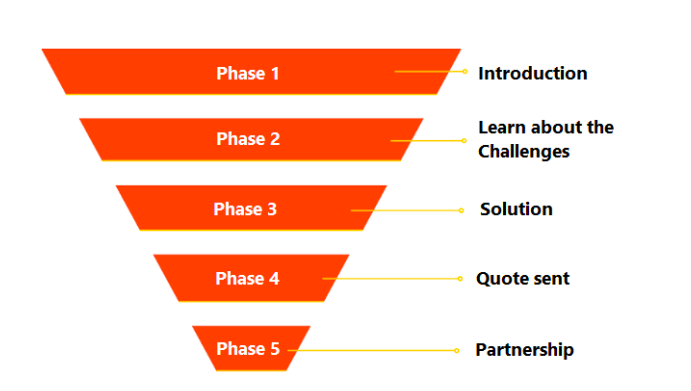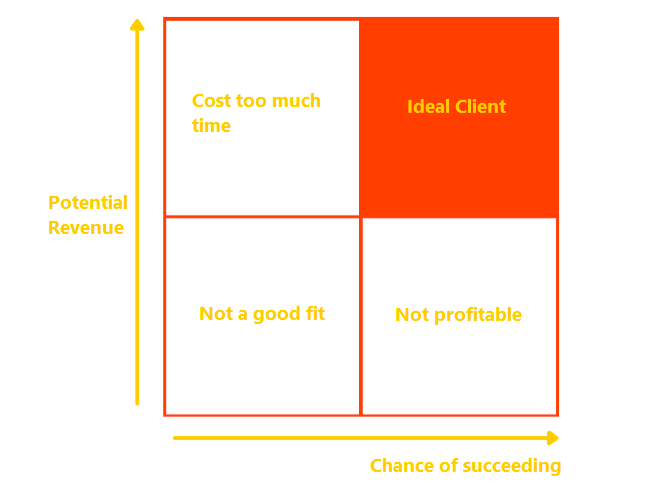Sell more and recruit less
It is a common mistake to hire more salespeople with the hope of generating increased sales. The sales department is the engine of any company; without selling products or services a company has no reason to exist. So when you want to grow, it is necessary to look at a company’s revenue and how to improve it. But how do you improve the performance of the sales department? There are several methodologies that can help you with this, some of which are described in the book “Predictable Revenue” by Aaron Ross. In this article I dive into the key insights from this book and how you can effectively use a customer relationship management (CRM) system, such as HubSpot, to optimize your sales process. Below you will find seven recommendations to improve your sales force.
- Focus on your sales process and not the number of salespeople
- Clarify sales definitions
- Implement cold calling 2.0
- Create specialized roles within the sales team
- Identify the three types of leads: Seeds, Nets, and Spears
- Eliminate common mistakes in the sales process
- Automate sales tasks
- Introductory meeting
- Discussion about problems/challenges
- Defining a solution to the problem
- Preparing and sending a quotation
- Collaboration
If you were to draw these steps, it would look like the diagram below. This is just an example; a more complex sales process may have additional steps in it.

Once you have this process well mapped out, you can better evaluate each step. What percentage of potential customers move on from the initial introduction to the next stage? Why do they drop out? Maybe these companies were not a good fit for you, or maybe the introductory script is not effective, because the wrong questions are being asked.
Want a better understanding of what your sales process looks like yourself?
Clarify sales definitions
It is important for everyone in the company to speak the same language. Make sure you have clear definitions for the terms within the sales process such as: Prospects, Leads, MQLs, SQLs, Opportunities, Closed Deals and any other definitions. If you find it difficult to determine the difference between definitions, you can use the example below of a men’s clothing store in a high street.
- Prospects: All men within a certain age range in the high street, for example, men between 30 and 40 years old
- Leads: The men who stop in front of the store and look inside
- MQL: The men in the clothing store
- SQL: When someone in the clothing store approaches the salesperson with questions or tries something on themselves
- Opportunities: The man is satisfied and wants to buy the item (but hasn’t yet paid)
- Closed Deals: The man who paid for the item
Determine how these terms should be defined within your organization. When terms are clear to everyone, it becomes easier to send the right information to the right people.
Implement cold calling 2.0
In the age of digital transformation, cold calling has evolved as well. To be efficient with time and money, it is important to know who you are going to approach. There are several online tools that can help you assess prospects in advance to see if a company may be of interest. This prevents you from wasting too much time on a company that does not fit within your target audience. This process is also called prospecting.
It is very important that your target market is clearly identified so that prospecting goes well. Otherwise potential opportunities are lost, or a lot of time is wasted pursuing the wrong opportunities. One example is learning during an introductory meeting that the company does not fit the profile of your ideal client.

Once your targets are in order, a list of companies of interest can be compiled. Then you can look for the right contact person within this organization. For example, do you always work with Product Managers? If so, see if you can find the details of the product managers at the target companies. Or ask for the product managers at these companies; this way you can get in touch with the right person within an organization sooner.
Then you can send all these people a LinkedIn message or email before calling them. When you get a response, the leads are no longer cold because they are expecting your call.
Create specialized roles within the sales team
To set up your sales process properly, it is advisable to specialize roles within the B2B sales team. Within an organization, you can set up the teams by specializing individuals into:
- Sales Development Team, consisting of two different specializations:
1. A team dedicated to following up on incoming leads through the website, webinars, social media, etc.
2. A team dedicated to prospecting and identifying where the greatest opportunities lie, using the cold calling 2.0 strategy - Account Executive: this is the team responsible for bringing in the deal
- Customer Success: this team is responsible for relationship management and customer retention.
This structure makes it clear what the responsibilities are within the sales department, and allows everyone to focus on their own specialty. This in turn makes everyone better at their area of expertise and really gets the B2B sales engine going!
Identify the three types of leads: Seeds, Nets, and Spears
Each opportunity has a unique sales cycle and Return On Investment (ROI). You can divide most common leads into seeds, nets and spears:
- Seeds come from “word of mouth” and PR
- Nets come from broader marketing efforts such as pay per click
- Spears are generated by focused work by the sales team responsible for field sales, such as cold calling 2.0

In the diagram above, the different types of leads are evenly distributed, but in practice this will often be different. These three methods create an influx of potential opportunities within an organization; the type will vary by organization depending on where their focus lies. With a CRM system, you can efficiently track where opportunities come from and how they move through the sales process. This will give you better insights into how efficient your marketing channels are and where there are opportunities to improve your sales cycle. For example, a lot of leads may be generated through Google ads, but during the introductory meeting phase, you may discover that the lead is not a good match for your business. So don’t just look at the number of leads a channel generates, but also analyze the quality of these leads.
Eliminate common mistakes within the sales process
Mistakes can be costly; sometimes they can be monetized, but in many cases they cannot. Below is a brief list of common mistakes that you may not have considered:
- Setting unrealistic expectations. This can begin with a CEO who does not fully understand his or her own sales process and, as a result, has too high expectations, which does not help staff motivation.
- No clarity within one’s own sales process. When getting started with a CRM system, it is important that you first define and agree on the sales stages a customer goes through. Otherwise, it will take you a long time to do the initial system set up, or you will have a system that is not set up properly, and then you will have to do it all over again.
- Target audience is not clear. You can only spend your time once, so focus on your most important potential customers. Companies that generate the most sale and profits have one thin in common: they know exactly who their customers are and how to reach them.
Automate sales tasks
By using automation within a CRM system, you can better organize many processes within your sales department. This both saves time and increases the chances of acquiring important leads! Automations within a CRM system can relieve sales personnel of many repetitive tasks. It is important that you think about this carefully and determine in advance which tasks you would like to automate. Some examples of automated tasks are:
- Generating a reminder to follow up after you have sent a quote, to ensure that everything arrived well and if there are any questions.
- Status changes that inform everyone in the organization where the potential customer is within the sales cycle
- Sending a reminder prior to a call appointment
- Automatically saving the minutes after a video appointment
- Sending emails after someone requests a brochure from the website
Improve the sales process
You can’t improve a sales process overnight. Hopefully the tips above have provided some additional insights on where to start. Keep in mind that not everything needs to be implemented all at once. We are happy to give you tips that will get you started on improving your process step by step.

